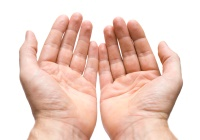Optical isomerism
Optical isomerism occurs when substances have the same molecular formula and structural formula, but one cannot be superimposed on the other. Put simply, optical isomers are mirror images of each other.
Molecules like this are said to be chiral (pronounced ky-ral). The different forms are called enantiomers. Optical isomers can occur when there is an asymmetric carbon atom. An asymmetric carbon atom is one which is bonded to four different groups. It forms a chiral centre of the molecule.
The four groups can be something hideously complex, or something comfortably simple like a hydrogen atom or a chlorine atom.
Remember:
- there must be four groups, and
- they must all be different.
Optical isomers can rotate the plane of plane-polarised light. When a solution is viewed from above:
- the (–) enantiomer rotates the plane anticlockwise (to the left)
- the (+) enantiomer rotates the plane clockwise (to the right).
A mixture containing equal concentrations of the (+) and (–) enantiomers is not optically active – it will not rotate the plane of polarisation. It is called a racemic mixture or racemate.
A molecular model and its mirror image
Hands
Hands are chiral objects. They have the same shape but are mirror images of each other.

What is here?
Lactic acid entantiomers
The models below show the optical isomers of lactic acid (2-hydroxypropanoic acid). Mammalian cells produce the (+) enantiomer. Different species of bacteria can produce the (+) enantiomer, the (–) enantiomer, or both enantiomers. Sour milk contains the (–) enantiomer. Synthetic lactic acid is usually a racemic mixture.
(-)-lactic acid
(+)-lactic acid
Butan-2-ol enantiomers
The models below show the optical isomers of butan-2-ol, CH3CH2CH(OH)CH3. The carbon atom to which the hydroxyl (—OH) group is attached is an asymmetric carbon atom. It has four different groups attached to it.
—OH —H —CH3 —CH2CH3
This carbon atom is the chiral centre of the molecule. The model of the (+) enantiomer is stationary so that you can try to rotate the model of the (–) enantiomer so they exactly superimpose.
Most natural amino acids are (–) enantiomers, and natural sugars are (+) enantiomers. You may see the letters l and d instead:
- (–) enantiomers are laevoratory, l
- (+) enantiomers are dextroratory, d.
(-)-butan-2-ol
(+)-butan-2-ol
This model cannot be animated but you can move it around in 3D, if you want to do this.
